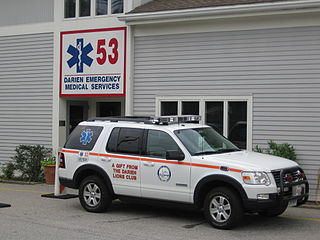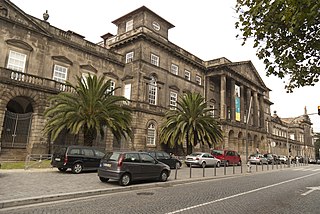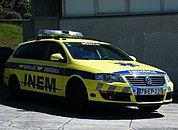
Emergency medical services (EMS), also known as ambulance services or paramedic services, are emergency services which treat illnesses and injuries that require an urgent medical response, providing out-of-hospital treatment and transport to definitive care. They may also be known as a first aid squad, FAST squad, emergency squad, rescue squad, ambulance squad, ambulance corps, life squad or by other initialisms such as EMAS or EMARS.

Emergency medical technician (EMT) and ambulance technician are terms used in some countries to denote a health care provider of emergency medical services. EMTs are clinicians, trained to respond quickly to emergency situations regarding medical issues, traumatic injuries and accident scenes.

A paramedic is a specialist healthcare professional who responds to emergency calls for medical help outside of a hospital. Paramedics mainly work as part of the emergency medical services (EMS), most often in ambulances. The scope of practice of a paramedic varies among countries, but generally includes autonomous decision making around the emergency care of patients.

A certified first responder is a person who has completed a course and received certification in providing pre-hospital care for medical emergencies. Certified individuals should have received much more instruction than someone who is trained in basic first aid and cardiopulmonary resuscitation (CPR) but they are not necessarily a substitute for more advanced emergency medical care rendered by emergency medical technicians (EMTs) and paramedics. First responders typically provide advanced first aid level care, CPR, and automated external defibrillator (AED) usage. The term "certified first responder" is not to be confused with "first responder", which is a generic term referring to the first medically trained responder to arrive on scene and medically trained telecommunication operators who provide pre-arrival medical instructions as trained Emergency Medical Dispatchers (EMD). Many police officers and firefighters are required to receive training as certified first responders. Advanced medical care is typically provided by EMS, although some police officers and firefighters also train to become emergency medical technicians or paramedics.

The London Ambulance Service is an NHS trust responsible for operating ambulances and answering and responding to urgent and emergency medical situations within the London region of England. The service responds to 999 and 111 phone calls, providing triage and advice to enable an appropriate level of response.

A nontransporting EMS vehicle,, is an emergency medical service (EMS) vehicle that responds to emergencies, but is not designed to transport a patient. For patients whose condition requires transport, an ambulance is necessary.

The Fire Services Bureau is responsible for fire and rescue services in Macau. Volunteer fire brigades in Macau dates back to 1851 and full-time department in 1883. Prior to 1851, the Portuguese military provided fire services in the colony. In 1999, the CB became a fully civilian agency. Today the department is organized under the Macau Security Force. The brigade is responsible for fire and rescue for both land and air.

Louisville Metro Emergency Medical Services is the primary provider of pre-hospital life support and emergency care within Louisville-Jefferson County, Kentucky. LMEMS is a governmental department that averages 125,000 calls for service, both emergency and non-emergency, each year.

In the United States, emergency medical services (EMS) provide out-of-hospital acute medical care and/or transport to definitive care for those in need. They are regulated at the most basic level by the National Highway Traffic Safety Administration, which sets the minimum standards that all states' EMS providers must meet, and regulated more strictly by individual state governments, which often require higher standards from the services they oversee.

Emergency medical services in France are provided by a mix of organizations under public health control. The central organizations that provide these services are known as a SAMU, which stands for Service d'Aide Médicale Urgente. Local SAMU organisations operate the control rooms that answer emergency calls and dispatch medical responders. They also operate the SMUR, which refers to the ambulances and response vehicles that provide advanced medical care. Other ambulances and response vehicles are provided by the fire services and private ambulance services.

Emergency medical services in the United Kingdom provide emergency care to people with acute illness or injury and are predominantly provided free at the point of use by the four National Health Services of England, Scotland, Wales, and Northern Ireland. Emergency care including ambulance and emergency department treatment is only free to UK Nationals and a charge may be made to those not entitled to free NHS Care.
Ambulance Services in Hong Kong are provided by the Hong Kong Fire Services, in co-operation with two other voluntary organisations, the Auxiliary Medical Service and the Hong Kong St. John Ambulance.

Healthcare in Portugal is provided through three coexisting systems: the National Health Service, special social health insurance schemes for certain professions and voluntary private health insurance. The SNS provides universal coverage, although in 2012 measures were implemented to ensure the sustainability of the service by the introduction of user fees to be paid for at the end of treatments. In addition, about 25% of the population is covered by the health subsystems, 10% by private insurance schemes and another 7% by mutual funds. The Ministry of Health is responsible for developing health policy as well as managing the SNS. The Health Regulatory Entity (ERS) is the public independent entity responsible for the regulation of the activity of all the public, private and social healthcare providers. In 2019 the government proposes to scrap all fees, which constitute about 2 percent of the NHS's budget, apart from some hospital emergencies.

Motorcycle ambulances are a type of emergency vehicle which either carries a solo paramedic or first responder to a patient; or is used with a trailer or sidecar for transporting patients. Because of its size and performance, a motorcycle ambulance is able to respond to a medical emergency much faster than a car, van, or fire truck in heavy traffic, which can increase survival rates for patients suffering cardiac arrest.

Emergency Medical Services in Spain (EMS) are public services usually provided by regional Governments.
The New York City Fire Department Bureau of Emergency Medical Services, also known as the FDNY EMS Command, or FDNY EMS, was established on March 17, 1996, following the merger of the New York City Fire Department and New York City Health and Hospitals Corporation's EMS division. FDNY EMS covers all five boroughs of New York City with Emergency Medical Technician (EMT) and Paramedic staffed ambulances as well as various specialized response vehicles.
Air medical services is a comprehensive term covering the use of air transportation, aeroplane or helicopter, to move patients to and from healthcare facilities and accident scenes. Personnel provide comprehensive prehospital and emergency and critical care to all types of patients during aeromedical evacuation or rescue operations aboard helicopter and propeller aircraft or jet aircraft.
The Puerto Rico Medical Emergencies Corps (Spanish: Negociado del Cuerpo de Emergencias Médicas de Puerto Rico or is an agency of the executive branch of the government of Puerto Rico that responds to fire, police, and medical emergencies in Puerto Rico. The agency is assigned to the Department of Public Safety, which also includes the Puerto Rico Police Bureau, the Puerto Rico Firefighters Bureau, and many other agencies. The NCEMPR divides Puerto Rico into six regions for operational purposes with each region having its own dispatch. NCEMPR is directed by Abner Gomez Cortes and the commissioner is Guillermo Torruella.

The Hospital of Psychiatric Emergencies Marcelo Torcuato de Alvear is a monovalent public hospital for acute psychiatric patients in the city of Buenos Aires, Argentina.
The McKeesport Ambulance Rescue Service, formally the McKeesport Ambulance Authority, is a non-profit emergency medical services agency which provides emergency medical and patient transport services to the City of McKeesport and a number of surrounding municipalities. It was established in 1991, and is assigned station number 620 by Allegheny County Emergency Services.

















